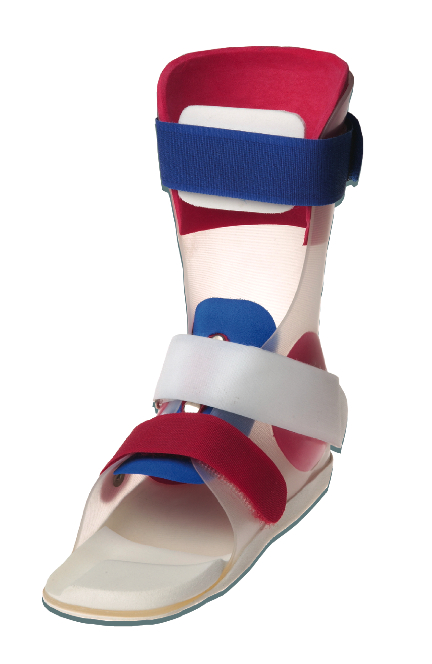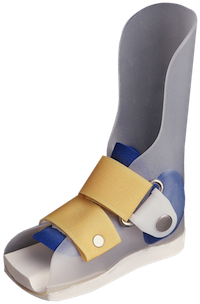Tone Reducing Orthoses (TRO)

Over the past decade we have seen a marked increase in the acceptance and use of tone-reducing (or tone-inhibiting) orthoses. We at Freedom Fabrication have worked hard to assemble a group of designs which meet the needs of the the majority of patients encountered. However, we understand that you are the best judge of your patient’s needs, and therefore we are always willing to develop custom designs to your specifications.
All of our tone reducing orthoses can be fabricated from your standard circumferential cast or from molds using custom or prefabricated foot plates. Nevertheless, due to the precise nature of these devices, accuracy is imperative. For this reason, please feel free to contact us for a measurement form (or download the form here), and additional information on casting procedures.
To help increase compliance we also offer a wide array of colored materials and accents. By increasing the visual impact of these products we hope to make them easier for your patient to accept. Color options may change due to product availability.
Velcro Fasteners:
Black, Dark Blue, Red, Yellow, Beige, White, Baby Pink, Baby Blue, Purple, Hot Pink, and Neon Green.
Foam Padding:
Solids – White, Black, Red, Yellow (gold), Green, Blue, Brown, and Flesh.
Standard Tone Reducing Orthoses (TRO) Designs
This basic floor reaction orthosis allows for easy donning with good hind foot control and a tone-reducing foot plate.
Indications for this orthosis are pronounced hip and knee flexion at mid stance generally accompanied by collapsed mid foot, external rotation at the foot, and neurological impairment which produces a tonal response.
Contraindications include patients with fixed dorsi-flexion contractures, and non-ambulatory patients. Patients with very large feet and/or bulbous heels, and thin calves may find donning difficult to impossible.
This articulating ankle foot orthosis allows the use of various articulation methods for excellent provision or limitation of the patient’s range of motion, and the wrap around trim line helps to correctly orient the alignment of the foot.
Indications for this orthosis include patients with a mild to moderate plantar-flexion response at mid stance to toe off.
Contraindications include patients with fixed contractures, and patients with a very strong plantar-flexion response.
These high backed trim lines allow excellent hind and mid foot control, a strong plantar-flexion resistance and a simple low profile fit that is very easy to don.
Indications for the number 30 T.R.O. include those patients with strong plantar-flexion responses, and poor mid foot alignment, as well as patients who are too small for a number 20 T.R.O.
Contraindications include patients with fixed contractures, and and crouched gait.
This high profile foot orthosis is a good choice where mid foot alignment is desired. Essentially, a U.C.B. type orthosis, the wrap around trim lines allow a very comfortable control surface with minimal shoe fit interference.
Contraindications are, of course, any one requiring strong heel or ankle control.
This basic floor reaction orthosis allows for easy donning with good hind foot control and a tone-reducing foot plate.
Indications for this orthosis are pronounced hip and knee flexion at mid stance generally accompanied by collapsed mid foot, external rotation at the foot, and neurological impairment which produces a tonal response.
Contraindications include patients with fixed dorsi-flexion contractures, and non-ambulatory patients. Patients with very large feet and/or bulbous heels, and thin calves may find donning difficult to impossible.
Formally known as the “Yankus” brace, this orthosis consists of two essential components. The first is a thin polyethylene supra-maleolar orthosis similar to the number 40 T.R.O., and second, a polypropylene outer frame with the same configuration as a number 10 T.R.O.. The rationale for this design is simple. By providing a thin inner boot we are able to achieve excellent tone reduction properties with solid heel, mid foot, and dorsal control and still offer a floor reaction orthosis with a frame shape rigid enough to accurately transmit the desired ground reaction force.
Contraindications are similar to the number 10 T.R.O.
Formally known as the “Silva” orthosis, this design is similar to the number 60 T.R.O. in that it is comprised of two components. First, we use the polyethylene inner supra-maleolar orthosis for accurate control of the mid and hind foot, then we house it in a frame of thicker polypropylene with standard solid ankle A.F.O. trim lines. Adjusting the lateral trim lines of the outer frame will give anything from a posterior leaf spring to a rigid ankle depending on the individual patient needs.
Contraindications include patients with strong crouching gait, or where shoe fit will be problematic.
Our standard Tone Reducing orthoses designs meet the needs of most patients. But when a patient’s pathology calls for a unique solution, Freedom Fabrication can develop a custom design to your specifications.
2








